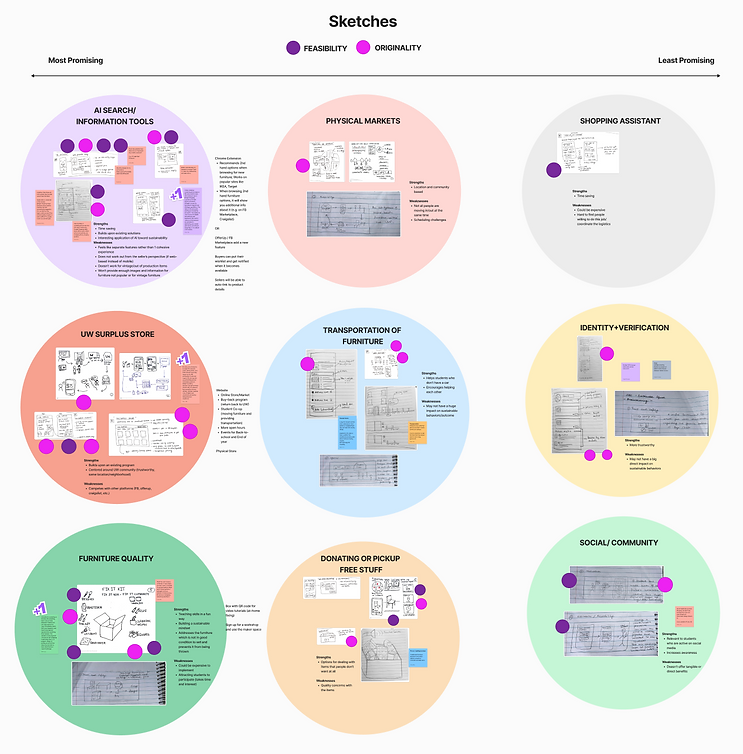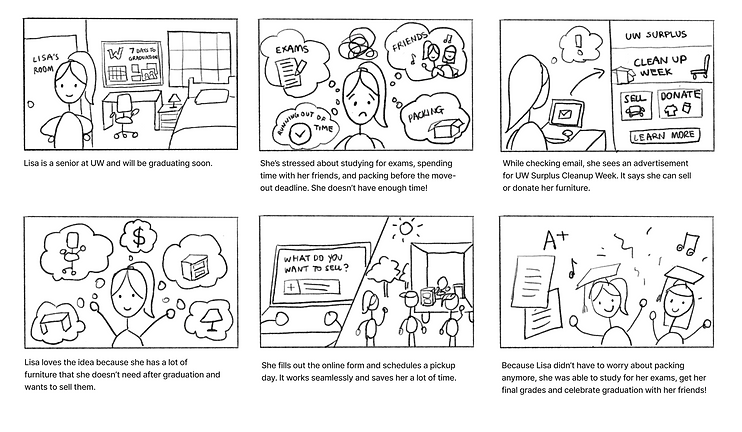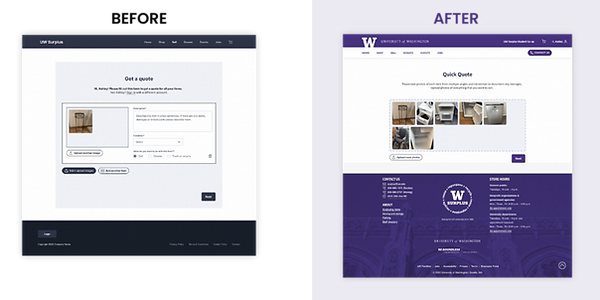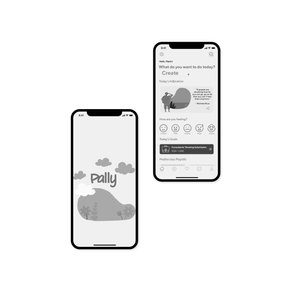Surplus Store
Streamlining the process of buying and selling second-hand furniture
Design casestudy as part of the User Centered Design curriculum
HCDE, Fall quarter, 2022
10 week sprint
Key contributions: user research, product strategy and identity, UI and UX design

Young people move around often due to school or work, and the moving process requires buying and selling furniture. During the process, they face several challenges such as transportation, carrying heavy objects, lack of time, the validity of the seller and the quality of the furniture.
The proposed solution envisions a potential collaboration with the University of Washington Surplus Store, in the form of a student co-op. The key features proposed include easy and trusted buying and selling solutions, pick-up and delivery options as well as workshops to educate students on fixing their furniture.
By collaborating with the UW Surplus Store, we wanted to reinforce a communal feeling amongst students and also enrich the community itself. By creating a furniture eco-system in UW, all individuals of the community can aim to do something good not only for each other, but also for the environment.
This project is a brainchild of four HCDE graduate students from University of Washington who shared similar experiences with this process. We proposed this as a problem for our User Centered Design project themed- “Designing for a Changing Environment”, in the Fall of 2022.
Here is a video of our pitch
“How can we improve the experience of buying and reselling furniture sustainably for young adults who are frequently moving to new places?”
Students need more efficient and feasible solutions to buy and sell furniture than what is currently present in the market. To encourage more students to participate in this sustainability venture, a coherent system is required.
Secondary Research
We conducted a competitive analysis of existing platforms, including Facebook Marketplace, Offer Up, Goodwill and Craigslist. Current gaps and opportunities include:
-
Unclear product descriptions
-
Lack of clear photos
-
Missing pick up and delivery info
-
Low seller profile credibility
-
Low communication efficiency
-
Unfriendly UI

Primary Research
We conducted semi-structured interviews with nine participants to learn more about behaviors, wants, needs and pain points of current students and graduates. We also administered surveys to better understand our target users. In the later stages of the project we conducted a stakeholder interview with UW Surplus, and visited their warehouse to do a tour and interview.

Statistics from our research (% of the respondents cited this)

UW Surplus Store from our visit
Target Audience
The target audience we identified:
Primary users
-
College students
-
Newly graduated students
Stakeholders
-
UW Surplus
-
Student Cooperative
Personas
Based on our research, we created personas to help clarify our target user for the design process.


Design Requirements
To address the needs of Raj and other college students, our design solution should:
-
Provide affordable second hand furniture
-
Make it easy for students who don’t have a car
-
Consistent furniture listing information
-
Fast turnaround and communication
-
User profile verification
-
Education and events of sustainable furniture
During our brainstorm sessions, we sketched a wide range of ideas and then created an affinity diagram to examine each theme.
Our most promising ideas were: AI search tools to help buyers and sellers, collaborating with the UW Surplus store, and improving furniture quality through fix it workshops.

Storyboards
In the next phase we decided to continue exploring the UW Surplus store collaboration, focusing on creating a service that would help the UW community. We created a storyboard to illustrate how a student would experience selling their furniture through UW Surplus.

User Flows
The following user flows show the end to end experiences for students who are buying, selling, or fixing furniture through the UW Surplus platform.

Information Architecture
The information architecture is focused on the website mainly to articulate the information hierarchy and the user experience.

Medium Fidelity Prototype
We created a medium fidelity prototype to show the core user flows for buying and selling furniture on the UW Surplus platform.

Usability Testing
A total of 4 participants, who are graduate students at the UW were recruited. The test was focused on shedding light on the understanding and discoverability of the website,if they were able to understand the flow of the website, and if they faced any challenges or issues during the completion of a task.
Some Major Challenges that Users Encountered That Were Addressed:
1. Providing a way to filter by price and other criteria
One of our design principles was to offer affordable options. Since students have a low budget, they needed a filter for their ideal price range.

Adding a filter pop-up
2. Reduce cognitive overload in the Checkout screen.
Users found it overwhelming to have interactive elements on the right, where the expectation was to view confirmations. This is one of the key tasks for shoppers so we needed to simplify and streamline the checkout experience.

Reduce Cognitive load
3. Introduction of a new feature
The “Batch Upload” feature was ambiguous. It was unclear if they should include photos for just one item or all the items they are selling. This is a hero feature and should be explained clearly to users so they can use it correctly to save time.

Explaining the hero feature better
High Fidelity Prototype
The high fidelity prototype is presented after several rounds of iterations by including the UW branding elements, improvements on pickup and delivery and refinements on sellers listing experience.


Buying flow

Selling flow
How the service is run
Due to time constraints, we were only able to focus on designing the customer facing interface.
Here is a service diagram of what might happen in the back-end, with respect to operations and the physical space.
Since our proposal is a Student Co-op, we expect the little profits that enter to be funneled into running the system, i.e- maintaining the platform, funding jobs, repair and upkeep

Future Explorations
If we had more time to work on the project, there are a few ideas which we could continue to explore to improve the platform
-
Allowing shoppers to create a Wishlist and notify them when products become available.
-
Showing similar products on the product detail page.
-
Ability to pay to place furniture on hold for an extended time period to allow alignment with move-in timeframe.
-
Adding a Deals banner on the Home page

Team Sustainable Squad at the Fall 2022 end of quarter HCDE showcase
As published in Bootcamp
Next up: Pally
